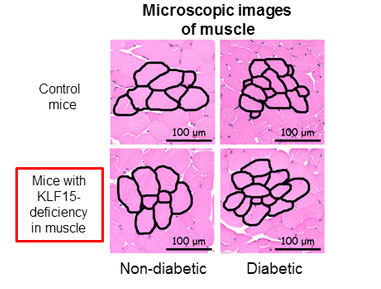News
Kobe University Group Discovers How Elderly Diabetic Patients Lose Muscles: Hopes for Drug Development to Counter Muscle-Loss Updated in May 2019
Research group at Kobe University clarified the mechanism of mass muscle-loss in elderly diabetic patients. When blood sugar rises, two types of proteins would reduce muscle mass. The results were published in the electronic version of the U.S.-based science magazine “JCI Insight” dated February 21, 2018.
Elderly people can suffer from a variety of diseases if their muscle mass decrease. Loss of muscles will reduce activity level. Reduction of muscles which can lead to deteriorated body function is called sarcopenia. Diabetic patients in particular are prone to this condition but sarcopenia’s mechanism had been unknown.
Prof. Wataru Ogawa (Division of Diabetes and Endocrinology, Department of Internal Medicine, Kobe University Graduate School of Medicine) discovered that mice which are artificially afflicted with diabetes mellitus, start to lose muscles. The team discovered that a protein named KLF15 would multiply inside the muscle. When they produced diabetic mice without KLF15, their muscles did not decrease.
The group analyzed these data and found that rise in blood sugar will suppress the break-up of KLF15 and will accumulate inside the muscle. Furthermore, another protein named WWP1 would promote the decomposition of KLF15.
Diabetes occurs when a hormone called insulin cannot work properly inside the body. Insulin regulates blood sugar levels and enhances cell-multiplication or cell-growth. Therefore, there has been a hypothesis stating that lack of insulin would hinder the multiplication or growth of muscle cells and would cause muscle loss. Prof. Ogawa’s team came across the functions performed by these two different proteins to verify that the rise of blood sugar level itself would directly trigger loss of muscles.
As of now, there aren’t any drugs to stop muscle-loss. According to the research group, the muscle-losing mechanism also applies to humans, too. If they are able to develop a medication that can enhance the function of WWP1 and to weaken the power of KLF15, it will benefit aged diabetic patients as well as many other elders prone to muscle loss.
JCI Insight article https://insight.jci.org/articles/view/124952








